ROAD RESEARCH REPORT: FERRARI 250/GT Berlinetta
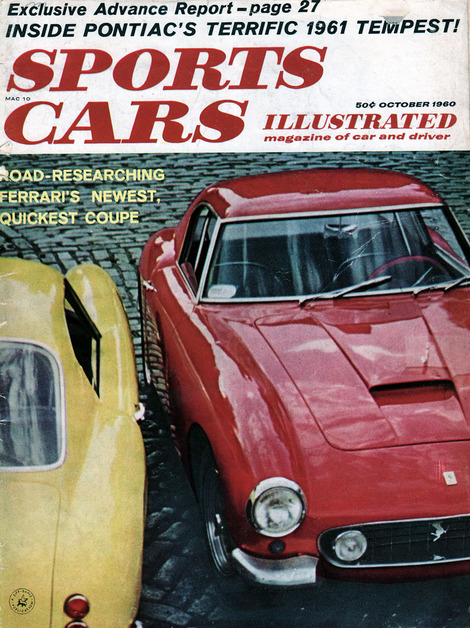
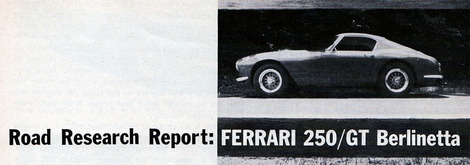
From the tips of its thrusting headlights to the end of its tucked-in tail, Ferrari's newest Berlininette exudes the essence of speed and power. For once the externals don't mislead. This is a fast car, potent almost to the point of being brutal. Its physical size is deceptive, though. A dozen yards away it looks compact, almost small. As you move closer and actually climb aboard it gets bigger, when you fire it up and get under way it becomes quite a healthy-sized machine! If this Ferrari seems bigger-than-life at rest, it's definitely so when on the go.
AN EXCELLENT ENGINE
The car is a fine one, amoung the world's best. We'll deal with the specifics of this later. Right now we want to establish, without equivocation, that it's powered by the greatest automotive engine in the world today. There's no other engine that begins to compare with it, that deserves mention in the same breath with the Ferrari V12. Let's name some others; the Jaguar twin-cam six? It's been around as long as the Ferrari, and has been impressively versatile, but unlike the V12 it's no longer winning major races today. The four-cam Porsche? Very sound, very successful engine, but with a birthday in 1953 it's a relative new-comer in the scene. The Chevy V8? An American immortal, extremely able, but also young by Ferrari standards and varying tremendously in tune between road and racing applications.
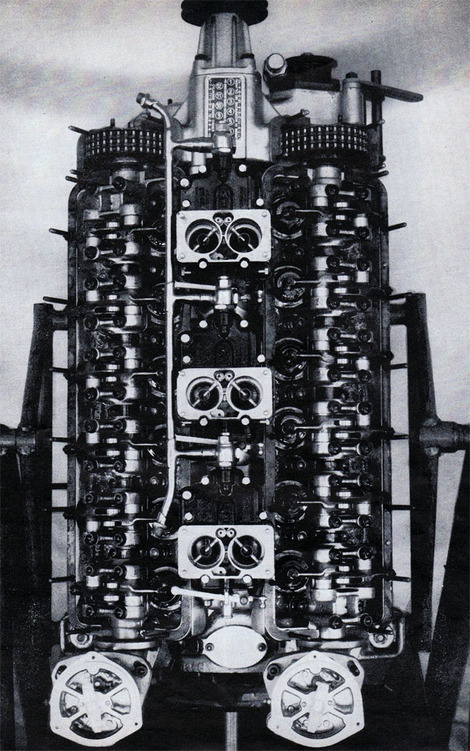
There must be some others. How about Mercedes? Even with fuel injection the 300-series six isn't competitive in racing today, while the M196 straight-eight didn't live long enough. Maserati has built many fine engines but hasn't been able to stick with a single one for very long, at least not one that's still with us today. The Meyer-Drake Offenhauser is an immortal power-plant, but definitely not versatile. In the twin-cam FPF, Coventry Climax has an excellent engine, but it hasn't really been baptized on the road yet. Once effective on both highway and race track, Lancia's classic V6 is now merely a pedigreed passenger-car engine.
Think of these examples. Think of all the car engines in production today, and see if you can come up with another that has lived for 13 years, almost constantly in production in different size variants, and always able to win major races or the classes with which it coincides. Far from being at the end of its life today, the V12 has just been redesigned in detail with an eye toward real quantity production and use. And what uses! The same basic engine that won Le Mans is propulsion for a silky-smooth, Lincoln-Continentalequue touring coupe. "Basic" is not a loophole here, either . There are differences between the road and racing V12s but they're remarkably few. For the background story on Ing. Colombo's masterwork, see September, 1959 SCI. To fill in the foreground in sharp detail, SCI drove one of the latest 250/GT Berlinettas (Charlie Kreisler's car, the fourth-place finisher at Sebring) over 1200 miles, on both road and race track - an unforgettable experience.
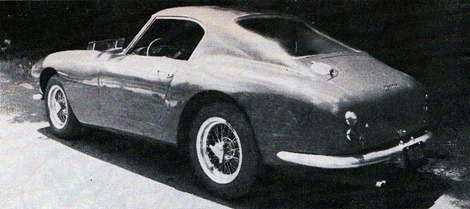 Four jutting exhaust pipes, soup-plate-sized fuel filler cap and a plastic bug deflector leave little room for doubt as to the Ferrari 250/GT Berlinetta's exact purpose in life.
Four jutting exhaust pipes, soup-plate-sized fuel filler cap and a plastic bug deflector leave little room for doubt as to the Ferrari 250/GT Berlinetta's exact purpose in life.
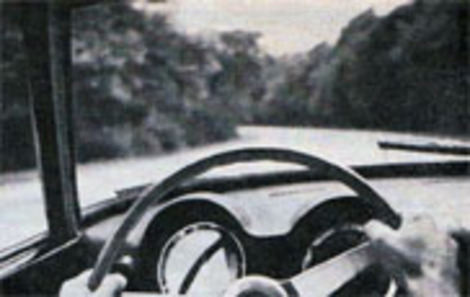 A driver's-eye view of the 250/GT. On the right is the 180-mph speedometer flanked by the revolution counter.
A driver's-eye view of the 250/GT. On the right is the 180-mph speedometer flanked by the revolution counter.
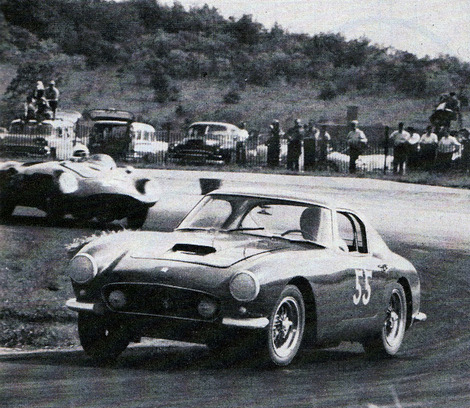 The SCI test car gets a little excise at Cumberland during an SCCA national event. It traveled to and from circuit on its own wheels.
The SCI test car gets a little excise at Cumberland during an SCCA national event. It traveled to and from circuit on its own wheels.
REDESIGN TO STANDARDIZE
During 1959, as part of a standardization program to smooth out the production process at Maranello, the type 250 V12 was given the first significant redesign in its history. The biggest single change - or decision, actually - was the use of the former Testa Rosa cylinder head on all the 250/GT engines across the board. This head design first appeared at Le Mans in 1957, on the car that served as the prototype for the production 250/TR of '58. It eschewed siamese intake ports (three per banks) in favor of six seperate ports per head, but to do this the spark plugs had to be moved around to the outboard, exhaust side of the engine. Our 1/8-scale cross-section in the data panel shows the older design; a photo shows the latest heads.
Why didn't they settle on the older heads? Obviously the new one allows much better breathing when properly carburated. Less obviously, moving the plugs and ignition wiring out the central vee lessens the danger of an errant spark igniting spilled gas from the carbs that also occupy that space. Crackled-painted shields above the exhaust manifolds deflect heat away from the wiring and from fingers feverishly extracting spark plugs, a consideration in long-distance racing.
A major departure from the gospel according to Colombo is the use of coil valve springs in place of the "mousetrap" or hairpin-type springs that have been inseparable from Ferrari philosophy for years. They were fitted for one reason only: service ease. The old hairpin springs took up so much fore-and-aft space in the valve chest that certain cylinder head hold-down studs couldn't be tightened while the valve gear was in place. For this reason, less fastidious mechanics would "forgrt" to torque the heads down a second time a few running hours after a rebuild - a highly necessary operation in an all-aluminum, wet-liner engine like this one. That frantic photograph on page 32, which also displays the roller-rocker valve gear, shows how accessible the studs are now.
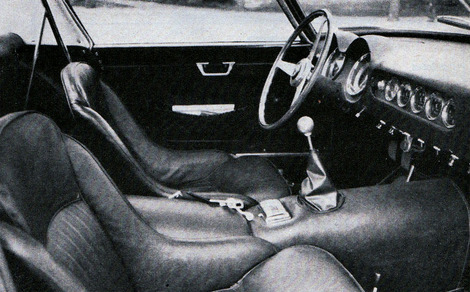 Comfortable seating for both driver and passenger plus well finished interior mark the Berlinetta as a true dual purpose car. It is one of the few machines that can win major races in "production" tune. Hand-fitting knob on gear lever is close to wheel rim, which is arm's reach from seat back.
Comfortable seating for both driver and passenger plus well finished interior mark the Berlinetta as a true dual purpose car. It is one of the few machines that can win major races in "production" tune. Hand-fitting knob on gear lever is close to wheel rim, which is arm's reach from seat back.
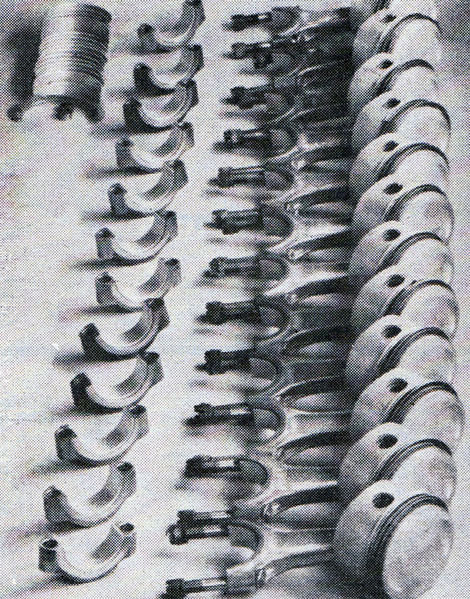 Twelve pistons and connecting rods help explain what costs all that money. These rods have the latest horizontal-spilt big ends.
Twelve pistons and connecting rods help explain what costs all that money. These rods have the latest horizontal-spilt big ends.
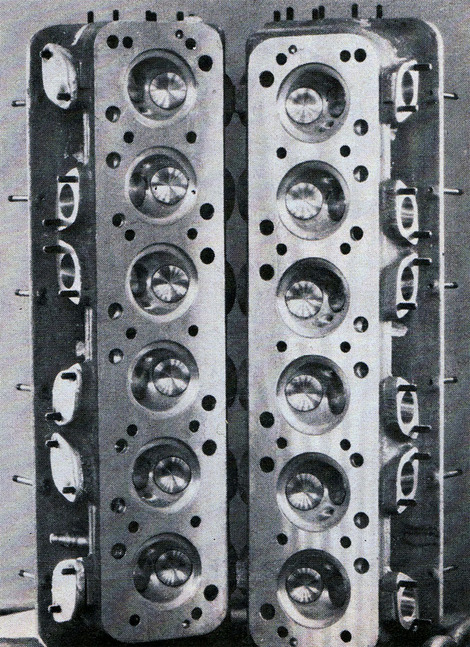 New cylinder head has plug hole on exhaust side, and seperate intake ports. Inner circle in chamber indicates bore of early 2-liter engine.
New cylinder head has plug hole on exhaust side, and seperate intake ports. Inner circle in chamber indicates bore of early 2-liter engine.
FAN BELTS AND BOTTOM ENDS
Another change from "racing" trim is in the generator mounting. Hitherto it's been cradled in the upper part of the big timing case casting, driven directly from the sprockets. The fan, when fitted, was then spun by a tiny fan belt from a pulley on the front end of the generator. Now that central sprocket is made to turn a pulley directly (through a cast extension that bears a plate explaining the firing order in both Italian and English), over which a longer belt runs to the generator, placed out on the right with a conventional adjustment, and to the fan, just below the drive pulley.
One extremely neat feature is the magnetic clutch fitted to the fan. A little thermostat in the top water pipe keeps tabs on the engine temperature, only clutching the fan to its pulley when water temperature rises above 170 degree F to 175 degrees. And the fan itself is an ordinary stamped part instead of an elaborate light-alloy casting. Another front-end change was abandonment of the original Ferrari re-usable oil filter in favor of a modern disposable-case filter projecting forward on the right side of the timing case. Our R.R.R. car had an additional filter for a secondary oil supply hung on the right side of the engine room.
Also related to the oiling system is the cast oil pan, newly-reshaped to be narrower at the front than before. For such a high-performance unit, by the way, the Ferrari V12 is almost unique in having a wet-sump lubrication system, with a single oil pump gear-driven from the crack nose. Even in the early Fifties the big 4.5-liter Ferrari Grand Prix V12s with almost 400 horse-power got along fine without extra scavenging pumps and oil reservoirs. While we're down this part of the engine, recall that the original small bore of the Colombo V-12 nade it necessary to split the connecting rod big ends along a 45-degree line so the bottom of the rod could be pulled out through the cylinder during an overhaul. Now that the engine's being built only as a three-liter, with a much bigger bore, the rod has been given a conventional big end, split at right angles to the shank.
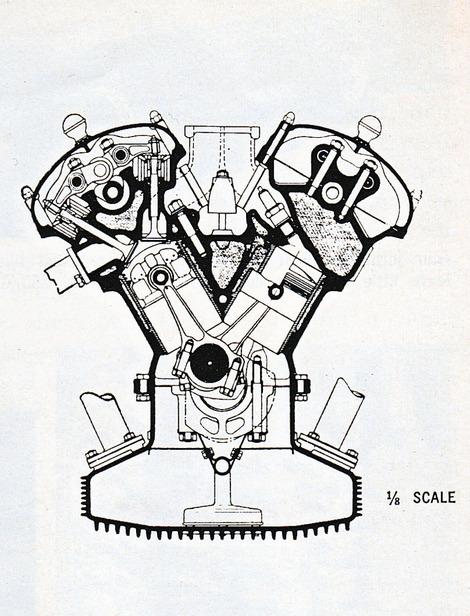
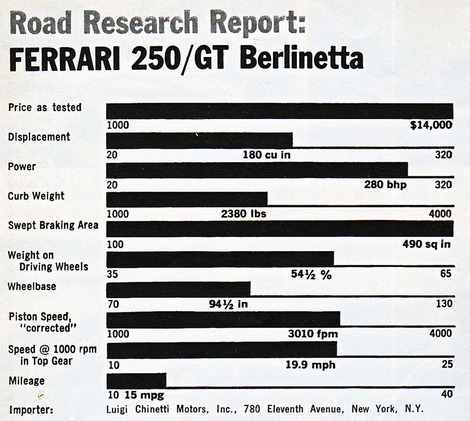
HOW THE V12 BEHAVES
That's what's been done to "standardize" this engine - this remarkable V12, the only power plant for cars with that many cylinders being built in the world today. It's no secret, of course, that this very multiplicity of cylinders accounts for the 250/GT's astounding versatility, allowing a very "wild" state of tune to be applied without giving it an ill temper. What happens to the driver's composure when he twists the ignition key 180 degrees to the right (90 degreessuffice for accessories only) and presses it to start, is another matter entirely.
There is no choke or rich-mixture control; a couple of pokes at the accelerator pumps of the triple Webers will do nicely if the weather's crisp. If it's hot or if the engine is, switch on the auxiliary electric fuel pump (a light reminds you it's on) to flush vapor lock out of the system. That pump is left on if you're driving the car hard in hot weather. With these precautions and a skilled foot on the throttle the V12 quickly finds its voice. It idles well, not smoothly with a hum but regularly with a rumble, and the actual idle speed can vary. You can vary it yourself by remote control with a big knob on the left wall of the cockpit, or you can wait for it to change of its own accord between 700 to 1000 rpm, depending on the weather and running temperature. About the latter, believe it or not: from mid-Manhattan, New York, prowling around town in ordinary traffic waiting for interminable lights, to the high speeds of the turnpike or race track, neither oil or water temperatures ever rose as high as the 190-degree mark! We didn't cheat; we left it idling at lights and in situations where sports cars of far more "practical" makeup would quickly have come to a boil.
EXCITING SOUND AND FURY
Throttle response is live and obedient to a toe's touch, above the Berlinetta's 1400-rpm green-line. If you stab it suddenly below that speed, either in or out of gear, there'll be a pause for throat-clearing before the action starts. When you take your foot off the pedal there's quick response too, a rapid drop in revolutions according to your needs. You'll get an idea why you switch off, too: the engine halts with a sudden "whump" that betrays the absence of excess rotating mass.
When it's running this ultimate engine is exhilarating, electrifying. Twelve pistons, 24 valves and roller-tipped rockers, two cams, a few yards of chain and an assortment of pumps combine to produce the most wonderful racket ever to reverberate in an eager enthusiasts eardrums. This soul-stirring cacophony is controllable - the first-time driver learns with a thrill - up to and including a gut-quivering roar with only gentle pressure of the right toe. In the cockpit the din is muted to a many-leveled mechanical whine up front and an urgent crackle from the quadruple tailpipes. It's quieter, but still not the kind of engine that keeps you checking the oil pressure "idiot light" to see whether or not it's stalled! Innocent of insulation, the Berlinetta's hood and firewall are built for lightness, not silence.
The view under the forward hinging hood is dominated by the big fiberboard chamber that mates with the hood scoop , supplying cool air to the carb intakes. The scoop and only slightly finer screens in the carb velocity stacks.
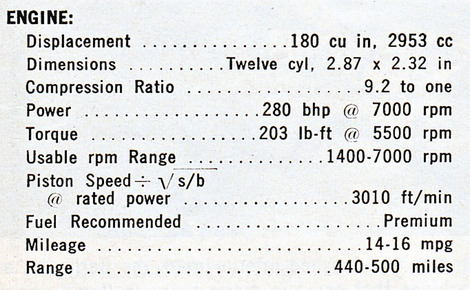
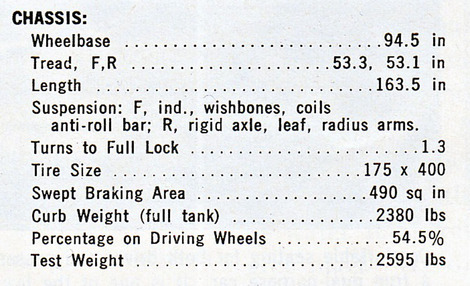
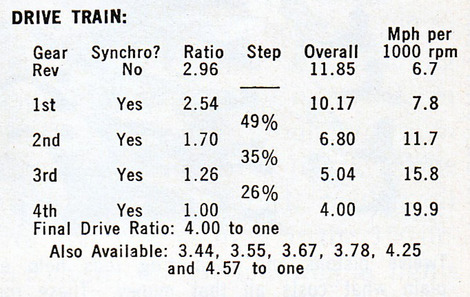
GEARBOX AND GEARING
Both the Berlinetta and the 250/GT Spyder California use the exact same four-speed gearbox, with ribbed case and complete Porsche synchromesh, that was mated to the 1958 Testa Rosa. Less Grand and more Turismo Ferraris have different cases with different back covers and remote shift layouts to make room for the optional Laycock overdrive unit. The design is rugged, as infinitely refined in its own way as the engine, and it feels like. Placed high beside the wheel, its lever is topped by the polished alloy mother and father of all great shift knobs. Move it about and you feel the hard, metallic internal limits of its action. Thrust it from gear to gear and feel its clean, welcoming engagement, as quick as synchromesh allows - excepting the line from second to third, which is a little slower in this precise pattern than it is in some sloppier boxes.
The third from the lowest offered, the 8/32 rear axle gear set proved a good all around cog, both for road use and for short-course competition. it's an odd ratio, though, in that the number of teeth on the ring gear (32) is a whole-number multiple of the number on the pinion (8), meaning that each ring gear tooth will always contract the same pinion tooth each time around. Usually the designer will try to insert an extra tooth here or there to produce a "hunting tooth" combination that will keep this from happening.
ROAD AND RACING ABILITY
The Berlinetta's performance was aptly summed up by a female passenger: "It's Instant Car," she said. Fond though we are of fast road machinery, talking every possible opportunity to exploit such cars to the full, we must admit that this 250/GT Ferrari has more sheer acceleration than you can use on the highway for more than a few seconds at a time. As whatever speed you're traveling those few seconds, at full throttle in the proper gear, project you so violently into another speed spectrum that you have to reorient yourself completely.
When we "took delivery" of the Ferrari its tires were practically new, and with their slick surfaces it was literally impossible to avoid a "chirp" or slight wheel-spin when starting up from rest. If you're in a hurry of course, wheel-spin is a real problem, but with a limited-slip differential, plenty of weight on the back, and the smooth but strong single-disc clutch, you're able to make use of every bit of bite the pavement offers. You need it, too, when the tach flicks by 5000 and that mighty engine breathes deep for its second wind.
At the other end of the Ferrari range, we've already mentioned its excellent manners in town. Puttering along at 40-45 mph in top gear, the Berlinetta gurgles and rumbles just below the "step" in the carburetion, erratically but not annoyingly. There's no danger of plug wetting, and just a tap of the throttle is needed to arouse the dozing cylinders. If you're wondering about mileage, expect about 15 miles per gallon on the open road - which will take you a long way on a glorious 31-gallon tankful. On second thought it might be better to have to fill up more often, just to be able to use that beautifully-recessed quick-acting filler cap.
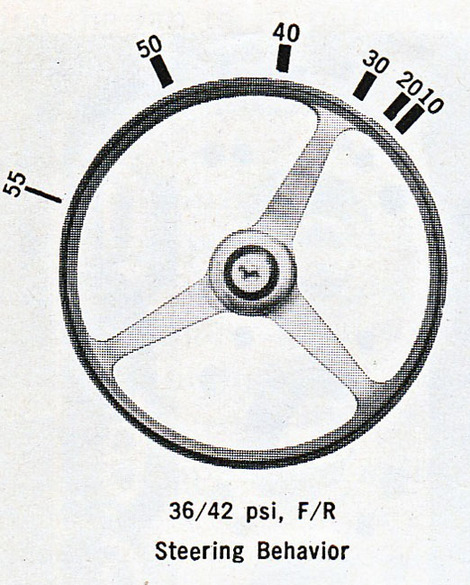
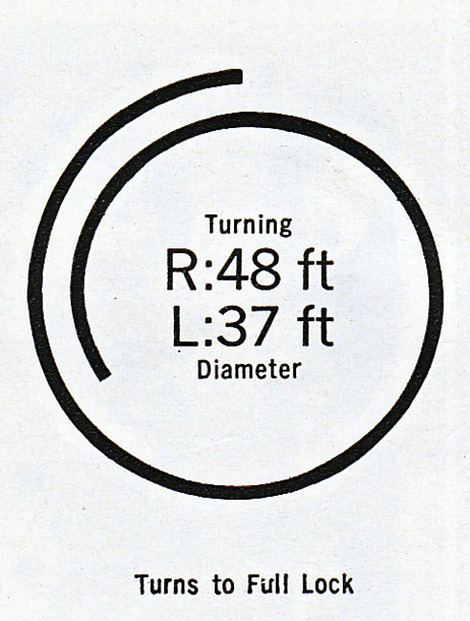
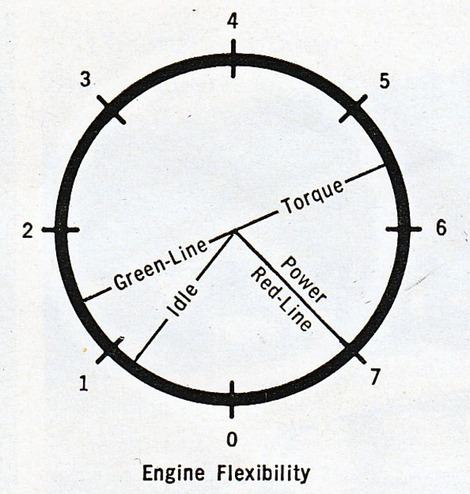
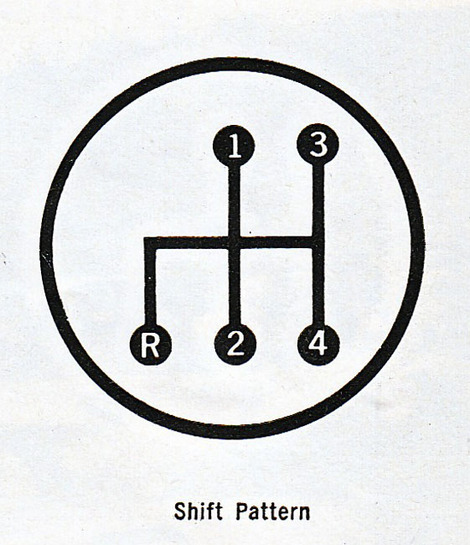
One of the big reasons for the 1960 Berlinetta's racing potential one that may make it about equal to the 1958 Testa Rosa in lap-time ability, is its use of Dunlop disc brakes. SCI complained bitterly about the Ferrari drums over a year ago, urging that discs be fitted to the 250/GTs. THey're here, and they transform the machine. Now there's completely progressive, solidly durable braking with full balance and without chatter of any kind. No servo is fitted so you have to apply plenty of pressure, and there's a "springy" feel as you tramp on the pedal that feels almost as if the disc calipers are flexing under the stress of application. We looked under the car and sure enough, they are flexing - not a lot, but visibly.
Another major change to both the 1960 Berlinetta and Spyder California was a reduction in wheelbase to fractionally more than 94 inches, 8 inches less than it had been and just a couple of inches longer than the 1958 Testa Rosa, which had won praise as a good handling car. As on the older Berlinetta the frame has a truss-like tubular superstructure along the sides under the doors, and something new has been added. The whole cowl and front end is carried and braced by a tubular network that verges on space-framing, daringly so for Ferrari. This made an already-stiff foundation even stiffer, and also supplied high mounting points for the large-diameter tubular shock absorbers that are now fitted at all fours: above the upper wishbones in front and sea-legged in the rear.
SELF-COMPOSED CORNERING
The basic 250/GT suspension is unchanged but refinements like these new shocks have moved toward a softer, more flexible, deeper-kneed modern system. Another innovation on this particular car was the use of Pirelli's new Cinturato S tire, made only in this one size so far, and recommended only for use on Ferraris. There's no structural difference between this and the ordinary "belted" Cinturato tire, but specially sturdy fabric plies and careful, one-at-a-time manufacture make it possible for Pirelli to suggest the use of this tire at sustained speeds up to 160 mph (130 is the suggested limit with all other Cinturatos).
Detail improvements to an already topnotch chassis have brought fourth a car that corners with immense composure. You just can't seem to catch it off-balance. Naturally, our Steering Behavior test was of unusual interest with this car: the results on page 36, call for some discussion. First, the graph clearly shows strong understeer, with more and more lock being called for as speed increases, but the Ferrari didn't have the logy, slow response that accompanies this kind of understeer. With quick steering and an embarrassing amount of power available the car was ready as any instant to have its radius tightened/opened or speed lowered/raised, at a rate of transition just as fast as you like. And when we came to the 55-mph point (the most valid 50+ mph we've recorded in this test) we forbore from added increments only became external conditions weren't favorable. The Berlinetta felt ready and willing to go just a bit faster, then just a bit faster yet - always working with you, offering you the tools with which to do the job.
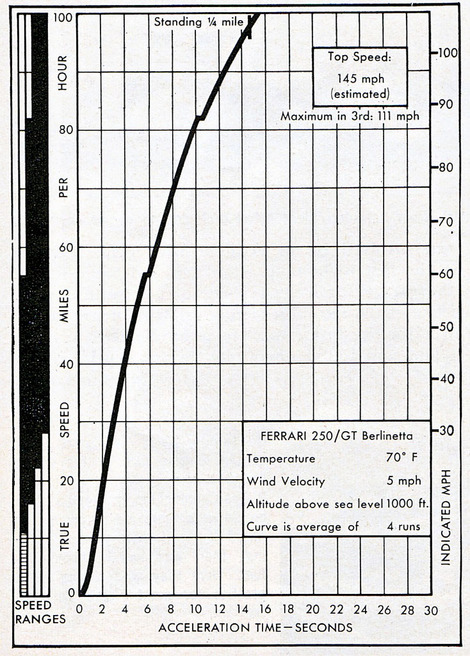
From the inside we were never aware of much roll but the Berlinetta does cant over in corners, causing a little delay in response as you "set it up" and slightly hampering quick changes from one lock to the other, as through ess-bends. Ease and precision of the steering was a great improvement over last year's cars, making the latest version sheer delight to handle. The steering's never hypersensitive, but has just enough self-centering action and reversibility to give you a direct wire to those all-important front tire contact patches. Far bigger on one side than on the other, the amount of steering lock was another matter entirely. It seemed to be limited, on one side at least, by the bodywork in the wheel well. We'll bet this was what happened on this car, though, to be sure of passing the F.I.A.'s new turning circle regulation, at Sebring, the lock may have deliberately offset to one side! What a shame if the scrutineers asked them to turn to the right.
IT EVEN RIDES WELL
For a fully-race worthy Ferrari, the Berlinetta's ride was a revelation. It's firm, especially with the Pirellis pumped up to the pressure that suit fast cornering, but it's also level-riding with an uncanny resistance to pitching for such a short wheelbase. In this respect the Berlinetta can definitely be classed as comfortable, especially with a tank full of gas, which holds the back end right down.
It's happy that the ride is good, since the seats are built for firm support and not for pampering of sensitive posteriors. Beautifully, lovingly made of black leather, they have high bucketed sides that render you a "push fit" in the actual cushion width of 12-13 inches. A long (191/2-inch) bottom cushion with an ample roll gives good support to the thighs, that the whole seat being canted back at a most comfortable angle. The seat rails and adjustment mechanism are standard Italian, awkward and erratic in use, but the range of adjustment is ample. Leg room, as such, is surprisingly better than in last year's Berlinetta, in spite of the shorter wheelbase, yet the space situation still isn't satisfactory for long-legged types on account of the pedal placement. All three pedals are on the same plane, to facilitate heel-and-toeing, which means that the accelerator leg must be cramped if the other is comfortably outstretched. One solution to this perennial problem might be to raise the seat an inch or so above its tracks, something the 361/2 inches of headroom (more than in all but a couple of American cars) would easily allow.
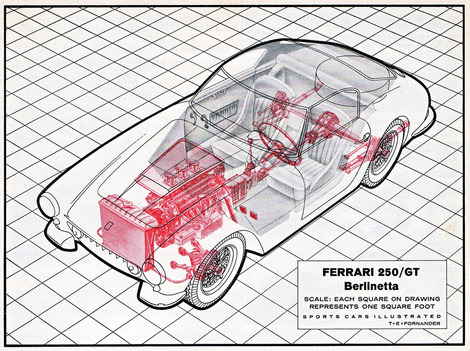
WHEEL AND DASHBOARD
An ample 61/2-inch clearance between steering wheel and seat is made possible by a new Ferrari technique: a universal joint in the steering column right behind the dash that allows the wheel to be slanted forward much more than in previous 250/GTs. This new position is top-notch, slightly on the high side and well awa from the seat for maximum action room. Slim (11/4-inch) corner pillars, the high roof line and slopping hood account for a great improvement in vision forward. There's no more "Berlinetta Hunch" from peering through, the old shallow windshield.
Constant reminders of the speed with which you're violating the countryside are the two biz tach and speedo dials (to 8000 and 180 respectively) under twin hoods in the trimly tailored crackle-finished dash. An old Ferrari failing is the multitude of minor switches and knobs scattered at random across the bottom of the panel, in no special order and without identification.
Life all the recent Ferrari sports bodies, this one was designed by Pininfarina. It looks it too, being shaped with a clean tautness that's a pleasant reminder of Ferrari racing coupes of yore and even of the classic Pininfarina Cisitalia coupe. Especially attractive is the side silhouette and the tightly-wrapped tail. Unfortunately opening the latter exposes little but the huge gas tank and spare wheel, but there are a few crannies that couldmaybe accommodate a fitted lunch box. If you're having something made, its biggest open volume is dimensioned this way: 31 x 81/2 x 19 inches. Behind the seats the main ara is a high, flat shelf 42 x 22 inches, not suited for carrying anything, but there is a ledge just ahead of it that can accept a volume of 33 x 8 x 8 inches. On this car it was partially blocked by a chrome-plated roll bar of very modest dimensions. Though this Berlinetta lacked the lockable glove compartment fitted to earlier cars on the line, it did have two 14 x 5-inch door pockets.
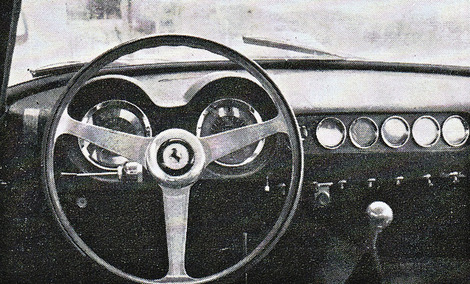
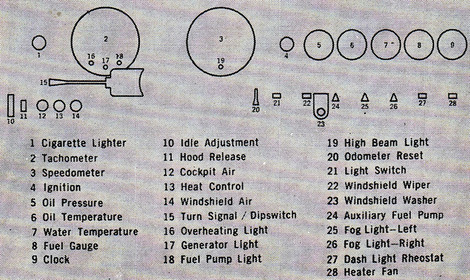
IMPRESSIVE IN ACTION
Pininfarina's design is executed by light body expert Scagletti, in Modena, which produces a coupe of remarkable lightness but not of impressive durability. Least satisfactory were the doors, which didn't sit firmly on their hinges and thus didn't close too well. The windows don't roll down all the way (the front lower edge actually protrudes forward through the edge of the door, as it is), and the window on the driver's side had ceased rolling altogether. Fortunately it ceased in the "down" position since cockpit ventilation is no more than adequate. There is a fresh-air vent that blows helpfully on the driver's feet, and there is a complete heating system built right in as standard equipment. We couldn't try it out since the whole thing was disconnected on this car, to eliminate one more item that could fail in a race.
In spite of these details the bodywork is generally well-done, and the interior is specially successful in avoiding the "assembled" look that has always been typical of the GT Ferrari. It looks, and feels, much more as if it was designed as a whole and not just added late rto give the driver someplace to sit. Even the view from the passenger's side is exciting in a cockpit like this one, as witness the reactions of one SCI staff member while being driven around Lime Rock Park by another staff member:
"You glance at the speedometer; its needle hovers over the 110-mph mark down the straightaway. There's wind noise, engine noise and exhaust noise. The timing stand blurs past. You feel an uncomfortable lurch as you brace against the heavy deceleration for the first corner. The throttle a cracked and you are pressed back and to the side unmercifully by brutal torque. A rush of hot, almost stifling air blasts back from the engine and smells of gasoline and hot rubber form a heady mixture. Through the corners you slam from side to side in the seat; the tach needle dances near its upper limit then plummets with the upshifts. Your driver sweats from effort and egine heat as he works the wheel and gear shift. Before you realize it - in just the short time you've been watching what's happening in the cockpit - you're "lost" on the course and it takes a moment to get year bearings again. Things happen fast in a Ferrari. You sweep into the downhill turn, tires scrubbing for the last ounce of adhesion, the rear end bobbles a little and with a roar you streak down the straight again." Ah, what a shame the Mile Miglia is no longer with us.
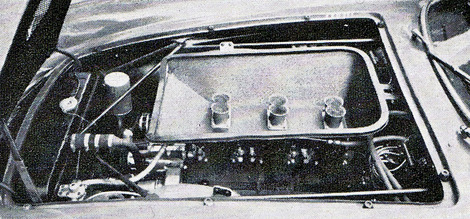
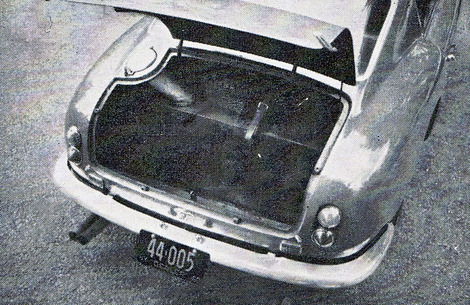
*ABSOLUTELY UNIQUE AUTOMOBILE *
At this point it's usual to evaluate a car in relation to its cost, a process that usually sends reporters scurrying after far-fetched justifications when confronted with a $14,000 price tag. We intend to approach this Ferrari, this particular breedof 250/GT Berlinetta, quite differently. We ask this question: What other automobile, anywhere in the world for any price, can do what this car can? Can you conceive of another vehicle that, on one hand, is not at all out of place in ordinary highway use and, on the other hand, is a virtual cinch to finish in the top five in a major international sports car race? Even with an unlimited budget, do you think you could come up with a design that would blend these conflicting requirements as successfully as the 250/GT Berlinetta does? Give it some thought. We have, and we've come to the conclusion that this car is not only a bargain at $14,000, it's an absolutely unique piece of machinery that knows not a single peer!
In our dual test of the 1959 Ferrari Berlinetta and California (SCI. September, 1959) we complained about these things: seats and seating position, steering stiffness, ride, and braking. Every one of these points has been tellingly rebutted by Maranello for 1960, plus a few more internal items that only Ferrari could be conscious of. The result is an automobile of absolute top class, the finest genuine sports car we have ever driven.
Some short you-tube looks
Posted 03/10/09 @ 12:39 PM | Tags: Ferrari Berlinetta, Ferrari 250 GT, Ferrari 250 GT Berlinetta, Sports Car Illustrated October 1960, Maserati, Mercedes, Chevy V8, Jaguar, Lancia, Meyer-Drake Offenhauser, Ferrari V12 engines, Spyder California, Pirelli Cinturato, Pininfarina, Scagletti